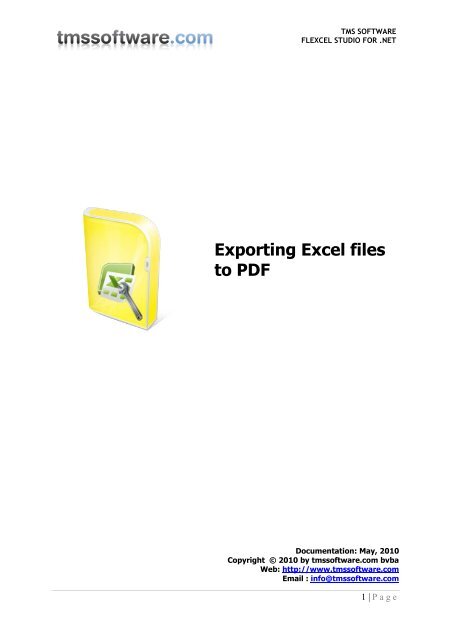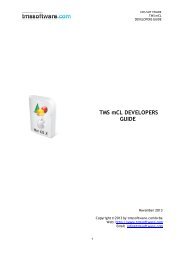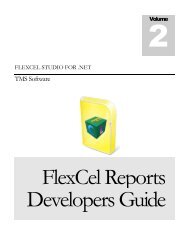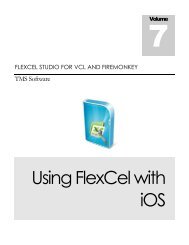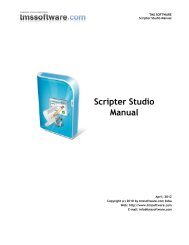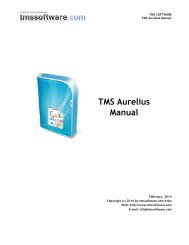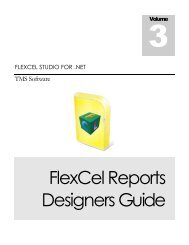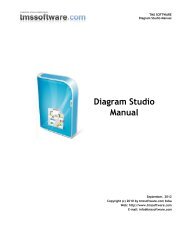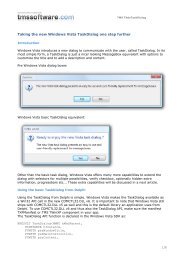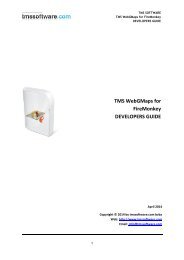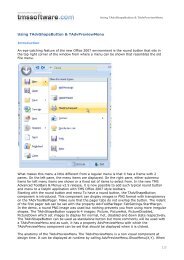Exporting Excel files to PDF - TMS Software
Exporting Excel files to PDF - TMS Software
Exporting Excel files to PDF - TMS Software
You also want an ePaper? Increase the reach of your titles
YUMPU automatically turns print PDFs into web optimized ePapers that Google loves.
<strong>TMS</strong> SOFTWARE<br />
FLEXCEL STUDIO FOR .NET<br />
<strong>Exporting</strong> <strong>Excel</strong> <strong>files</strong><br />
<strong>to</strong> <strong>PDF</strong><br />
Documentation: May, 2010<br />
Copyright © 2010 by tmssoftware.com bvba<br />
Web: http://www.tmssoftware.com<br />
Email : info@tmssoftware.com<br />
1 | P a g e
<strong>TMS</strong> SOFTWARE<br />
FLEXCEL STUDIO FOR .NET<br />
Table of contents<br />
Introduction ............................................................................................................. 3<br />
Creating <strong>PDF</strong> <strong>files</strong> ...................................................................................................... 4<br />
Introduction ......................................................................................................... 4<br />
Using PdfWriter ..................................................................................................... 4<br />
Using FlexCelPdfExport ............................................................................................ 4<br />
Preparing a file for printing .......................................................................................... 5<br />
Font Management ...................................................................................................... 6<br />
Selecting which fonts <strong>to</strong> use ...................................................................................... 6<br />
Accessing True Type data ......................................................................................... 6<br />
Going Unmanaged .................................................................................................. 7<br />
Fonts and <strong>Excel</strong> 2007 .................................................................................................. 8<br />
Setting the “Normal” font ........................................................................................ 8<br />
Dealing with missing fonts and glyphs ........................................................................ 10<br />
Signing Pdf Files ...................................................................................................... 13<br />
Cus<strong>to</strong>mizing the Signing Engine ................................................................................ 13<br />
Export <strong>to</strong> <strong>PDF</strong> and FlexCel recalculation ........................................................................ 15<br />
Using FlexCelPdfExport on MONO (linux) ........................................................................ 16<br />
2 | P a g e
<strong>TMS</strong> SOFTWARE<br />
FLEXCEL STUDIO FOR .NET<br />
Introduction<br />
FlexCel comes with a full <strong>PDF</strong> writer that allows you <strong>to</strong> natively export <strong>Excel</strong> <strong>files</strong> <strong>to</strong> <strong>PDF</strong>, without<br />
needing <strong>to</strong> have Acrobat or <strong>Excel</strong> installed. While the output will not be exactly the same as <strong>Excel</strong>, a<br />
lot of effort has been done <strong>to</strong> make it as similar as possible.<br />
3 | P a g e
<strong>TMS</strong> SOFTWARE<br />
FLEXCEL STUDIO FOR .NET<br />
Creating <strong>PDF</strong> <strong>files</strong><br />
Introduction<br />
FlexCel provides two ways <strong>to</strong> create a <strong>PDF</strong> file. At higher level, you can use FlexCelPdfExport<br />
component <strong>to</strong> natively convert an xls file in<strong>to</strong> pdf. At the lower level, you have the PdfWriter class,<br />
that provides a primitive API <strong>to</strong> create pdf <strong>files</strong>.<br />
Using PdfWriter<br />
PdfWriter is the low level option, and it was really not designed <strong>to</strong> be used directly, but <strong>to</strong> provide the<br />
methods FlexCelPdfExport needs <strong>to</strong> do its job.<br />
But, it can be used standalone <strong>to</strong> create a <strong>PDF</strong> file for scratch, or most likely <strong>to</strong> modify the output<br />
from FlexCelPdfExport using one of the Before/After CreatePage events.<br />
We will not cover it in detail here since methods are documented in FlexCel.chm, but we will mention<br />
that you can find an example in how <strong>to</strong> use PdfWriter in the API Demos.<br />
Using FlexCelPdfExport<br />
This is the high level option, and the one you would normally use. To export an xls file <strong>to</strong> pdf, you<br />
need <strong>to</strong>:<br />
1.Drop a FlexCelPdfExport component in<strong>to</strong> a form. (Or you might create it directly by code)<br />
2.Set the FlexCelPdfExport properties. You will find there are not a lot of properties (things like<br />
margins, printing gridlines or not, etc) and this is because all this information is read from the <strong>Excel</strong><br />
file. If you need <strong>to</strong> change them, change the associated properties on the attached XlsFile.<br />
3.Attach an XlsFile <strong>to</strong> the FlexCelPdfExport component, by assigning :<br />
flexCelPdfExport1.Workbook = someXlsFile.<br />
4.Export the file. You can use .Export <strong>to</strong> export only the active sheet, or<br />
BeginExport/ExportSheet/EndExport <strong>to</strong> export more than one.<br />
4 | P a g e
<strong>TMS</strong> SOFTWARE<br />
FLEXCEL STUDIO FOR .NET<br />
Preparing a file for printing<br />
<strong>Excel</strong> printing is “printer dependent”, that is, it can print different things <strong>to</strong> different printers.<br />
A rectangle printed <strong>to</strong> a standard laser printer can be 11 x 11 cm. and the same rectangle printed <strong>to</strong> a<br />
dot matrix printer might be 11.5 x 11.5 cm. As you can imagine, this might prove problematic when<br />
your file is designed <strong>to</strong> be printed in one page at 100% zoom. In some printers, it might actually print<br />
in one page, but in others it might print in two, or even in 4.<br />
In the example above, if your file was 11x11 and you were printing in an 11x11 page, it will fit in one<br />
page. But if the printer prints a little bigger, 11.5, it will actually need 4 pages <strong>to</strong> fit.<br />
<br />
Different from <strong>Excel</strong>, FlexCel printing is resolution independent (using GDI+) and it<br />
will print the same size everywhere. So when we calibrated the printing, we had <strong>to</strong><br />
choose a mix of all possibilities. If <strong>Excel</strong> prints a rectangle 10cm. wide in one printer,<br />
11 in other and 12 in other, FlexCel will print the same in all of them. We settled by<br />
emulating printing in a 600 dpi laser printer, but even this is not 100% exact. Laser<br />
printers don't print exactly the same either in <strong>Excel</strong>. In short, FlexCel results might<br />
not be the same size as <strong>Excel</strong> results for your particular printer.<br />
So whenever you need <strong>to</strong> “fit” in<strong>to</strong> a page, it is recommended that you use the “Print <strong>to</strong> Fit” setting in<br />
<strong>Excel</strong>. Look at the “Preparing for printing” section in the API guide for details on this. But if you don't<br />
want <strong>to</strong> use print <strong>to</strong> fit, make sure you leave a large enough margin at the right and at the bot<strong>to</strong>m, so<br />
the page prints fine everywhere, including FlexCel.<br />
5 | P a g e
<strong>TMS</strong> SOFTWARE<br />
FLEXCEL STUDIO FOR .NET<br />
Font Management<br />
Due <strong>to</strong> some .NET limitations the font handling can be problematic, so here we discuss some concepts<br />
that might help with the issue.<br />
Selecting which fonts <strong>to</strong> use<br />
First of all, you need <strong>to</strong> know that there are two different kinds of fonts supported by FlexCel's<br />
PdfWriter.<br />
1. <strong>PDF</strong> internal fonts. <strong>PDF</strong> defines 14 standard fonts that must be available <strong>to</strong> any <strong>PDF</strong> viewer,<br />
so you don't need <strong>to</strong> embed the fonts on the <strong>PDF</strong> document. They will always be supported<br />
by the <strong>PDF</strong> viewer. Those fonts include a Serif (Times New Roman-like), a Monospace<br />
(Courier-like) and a Sans Serif (Arial-like) alternatives, on four variants each (regular, bold,<br />
italic and bold italic) and two Symbol fonts.<br />
2. True Type fonts. Those are standard Windows fonts.<br />
When exporting <strong>to</strong> <strong>PDF</strong>, you can chose between three different ways <strong>to</strong> handle fonts, depending on<br />
the value you set on the FontMapping property.<br />
1. ReplaceAllFonts. This will replace all fonts on the xls file <strong>to</strong> the most similar ones on the 14<br />
standard fonts. This way you get the minimum file size and the maximum portability, but the<br />
exported <strong>PDF</strong> file might not look exactly the same, as you will lose all fancy fonts.<br />
2. ReplaceStandardFonts. This is a compromise solution. It will only replace Arial, Times New<br />
Roman and Courier for the standard fonts, and use True type for all the others. You will get a<br />
bigger <strong>PDF</strong> file (if you embed the true type fonts), but it will look as the xls file.<br />
3. DoNotReplaceFonts. This will only use true type fonts. It will be the one that better<br />
matches the xls file, but it will be a lot larger (if you embed the true type fonts) or might not<br />
look good when the user does not have the fonts you used installed (if you don't embed<br />
them)<br />
<br />
Also, you can choose whether <strong>to</strong> embed the True Type fonts or not. If you embed<br />
them, the file will be bigger, but also will render well when the user does not have<br />
the fonts on his machine. To avoid issues, it is normally recommended that you<br />
embed all fonts.<br />
Note that if you use Unicode characters, the fonts will always be embedded no<br />
matter which embed option you choose, because this is needed <strong>to</strong> ensure the<br />
Unicode mapping will remain correct.<br />
Accessing True Type data<br />
There is limitation .NET framework because there is no way <strong>to</strong> access the internal font data for a true<br />
type font. This data is needed <strong>to</strong> embed the font and also access font metrics not available on the<br />
framework.<br />
There were two alternatives for us <strong>to</strong> take:<br />
6 | P a g e
<strong>TMS</strong> SOFTWARE<br />
FLEXCEL STUDIO FOR .NET<br />
1. We could have used unmanaged code <strong>to</strong> call GetFontData on the Win32 API and get the<br />
actual data. This option was discarded because we want FlexCel <strong>to</strong> remain 100% managed.<br />
Staying 100% managed allows it <strong>to</strong> run on 64 bits, mono and everywhere, and it made no<br />
sense <strong>to</strong> go unmanaged just for one missing method.<br />
2. We could read the font <strong>files</strong> (*.ttf) directly. This option is better, but is not perfect either. The<br />
problem here is that the .NET framework gives the standard folder for lots of system folders,<br />
but not for the fonts folder. Again, <strong>to</strong> access the system fonts folder (where *.ttf are) we<br />
would need <strong>to</strong> go unmanaged.<br />
As going unmanaged is out of question (for us), we adopted a compromise solution. We use solution<br />
2) and assume fonts are on the<br />
\..\Fonts (On Windows). This is true for all installations of Windows we are<br />
aware of, but it might not be true for some or in the future, or in mono and Unix.<br />
If is empty, then we assume we are running on Linux, and we will try<br />
“/usr/X11R6/lib/X11/fonts/truetype”.<br />
If this folder does not exist, FlexCel will search on “/Fonts”. If you<br />
are running Linux, you might create a symbolic link <strong>to</strong> the place where the fonts are installed. (see<br />
the MONO section below for more information)<br />
As a last resort, FlexCel provides a OnGetFontFolder event that allows you <strong>to</strong> specify where fonts<br />
are s<strong>to</strong>red on your system. Here you can tell FlexCel where the fonts are.<br />
<br />
Avoid using this event if you can, since when you use it your code will not<br />
transparently run on MONO and Windows, you will have <strong>to</strong> have two different<br />
binaries. A Symbolic link from the FlexCel installation folder <strong>to</strong> the fonts folder should<br />
be a more elegant solution.<br />
Of course, you will not face any of these problems when using only standard <strong>PDF</strong><br />
fonts (and no Unicode)<br />
Going Unmanaged<br />
By the way, note that we said going unmanaged is out of question for us. If your application already<br />
uses unmanaged code, you can use the GetFontData event on FlexCelPdfExport <strong>to</strong> call GetFontData<br />
on the Win32 API, and return the font information <strong>to</strong> FlexCel. This way you will avoid scanning the<br />
font folder completely, and it can speed up a little <strong>PDF</strong> export.<br />
While we do not recommend that you go unmanaged for this since scanning the font folder is fast<br />
anyway, you have all options. Do what you prefer.<br />
For a demo on using the GetFontData event, see the ExportPdf demo.<br />
7 | P a g e
<strong>TMS</strong> SOFTWARE<br />
FLEXCEL STUDIO FOR .NET<br />
Fonts and <strong>Excel</strong> 2007<br />
<strong>Excel</strong> 2007 changed the default font in a new file <strong>to</strong> be “Calibri” instead of “Arial”. This might bring<br />
you problems if you develop in a machine that has <strong>Excel</strong> 2007 installed, but you deploy in a server<br />
that doesn't. There are two solutions for this:<br />
1. You can copy the <strong>Excel</strong> 2007 fonts <strong>to</strong> the server, and make sure you embed the fonts<br />
in the <strong>PDF</strong> file. Note that if you do not embed the fonts, any user who does not have <strong>Excel</strong><br />
2007 will not be able <strong>to</strong> see your <strong>PDF</strong> file correctly.<br />
2. If you want maximum portability, make sure you change all fonts <strong>to</strong> Arial or Times new<br />
Roman in your template before exporting.<br />
Setting the “Normal” font<br />
<br />
Especially important when changing the fonts is <strong>to</strong> make sure the “Normal” format<br />
uses a known font. You can see/change the normal font this way:<br />
1.In <strong>Excel</strong> 97-2003: Go <strong>to</strong> “Menu->Format->Style...” You should see the following dialog:<br />
Verify that the “Normal” style has a known font like “Arial”<br />
2.In <strong>Excel</strong> 2007: In the home tab in the Ribbon, select Cell Styles, right click in “Normal” and choose<br />
modify. Note that depending on your screen resolution, “Cell Styles” might show as a but<strong>to</strong>n or just<br />
display the “Normal” box directly in the ribbon.<br />
8 | P a g e
<strong>TMS</strong> SOFTWARE<br />
FLEXCEL STUDIO FOR .NET<br />
You will get a similar dialog <strong>to</strong> the one you got in <strong>Excel</strong> 2003. Again, make sure the normal style uses<br />
a font you have in your server.<br />
The “Normal” style is used not only for empty cells, but <strong>to</strong> set the column widths. For example, this is<br />
how an empty sheet looks with “Normal” style using Arial 10:<br />
And this is how it looks using Script MT 36:<br />
As you can see, the font used in the “Normal” style is used <strong>to</strong> draw the headings “A”, “B”, “1”, etc.,<br />
and even more important, it is used <strong>to</strong> calculate the column width. Column with is measured as a<br />
percentage of the “0” character width in the normal font. If you change the normal font, column<br />
widths will change.<br />
If you do not have the “Normal” font installed in your server, Windows will replace it with a substitute,<br />
and it will probably have a different width for the “0”, leading <strong>to</strong> a wrong column width. So it is<br />
important that you have that font installed in your server.<br />
9 | P a g e
<strong>TMS</strong> SOFTWARE<br />
FLEXCEL STUDIO FOR .NET<br />
Dealing with missing fonts and glyphs<br />
There are three main font-related problems you might find when converting an xls file <strong>to</strong> <strong>PDF</strong>, and we<br />
are going <strong>to</strong> cover them in this section. The errors are non fatal, and that means that the file will be<br />
generated anyway, but it will not look as good as it could.<br />
You can control what <strong>to</strong> do when any of these errors happen by hooking an event <strong>to</strong> the<br />
FlexCelTrace static class. From this event, you could write a log file when any of these errors<br />
happen, warn the user, or just raise an exception if you want <strong>to</strong> abort file generation.<br />
Problem 1: Missing fonts<br />
This is normally the easiest one <strong>to</strong> solve, and normally happens when deploying an application <strong>to</strong> a<br />
server. As explained in the section above, this often happens with “Calibri” font that gets installed by<br />
<strong>Excel</strong> 2007, and probably will not be installed in the server. As FlexCel needs the font <strong>to</strong> be present in<br />
order <strong>to</strong> create the pdf file, it will substitute it with a “similar” font, normally Arial or Microsoft sans<br />
serif.<br />
This might not be an issue if there are any fonts in the system that are similar <strong>to</strong> the one being<br />
replaced, but it can be a big issue with Calibri, since that font has very different metrics from the font<br />
it gets replaced (Arial). As an example, here you can see an <strong>Excel</strong> 2007 exported <strong>to</strong> <strong>PDF</strong> in a machine<br />
that has Calibri installed an in other that doesn't:<br />
With Calibri installed in the fonts folder:<br />
Without Calibri installed (Replaced by Arial):<br />
10 | P a g e
<strong>TMS</strong> SOFTWARE<br />
FLEXCEL STUDIO FOR .NET<br />
As you can see in the images, Calibri is much narrower than Arial, so the text in cell B2 “This Text is in<br />
Calibri” is cut and only “Calibri” shows in the second screenshot. If you are seeing lots of cut text in<br />
the server while the <strong>files</strong> are exported fine in your development machines, this is probably the cause.<br />
The solution for this problem is easy; make sure you have all the fonts you use installed in your<br />
system. If you want <strong>to</strong> get notified whenever this au<strong>to</strong>matic font replace happens, you can catch the<br />
“FlexCelError.PdfFontNotFound” errors in FlexCelTrace, and use it <strong>to</strong> notify the user he should install<br />
the missing fonts.<br />
Problem 2: Missing Glyphs<br />
This problem happens when you are using a font that doesn't contain the character you want <strong>to</strong><br />
display. If you for example write<br />
“ 日 本 に 行 きたい。”<br />
inside a cell and keep the font “Arial”, you will see the correct characters in <strong>Excel</strong>, but when exporting<br />
you might see blank squares like this:<br />
The reason for this is that “Arial” doesn't actually contain Japanese characters, and <strong>Excel</strong> is “under the<br />
hood” using other font (normally MS Mincho) <strong>to</strong> display the characters. To emulate this behavior,<br />
FlexCel provides a “FallbackFonts” property, where you can enter a list of fonts <strong>to</strong> try if the font that<br />
was supposed <strong>to</strong> be used doesn't have the character. If no font in the FallbackFont chain contains the<br />
glyph, you will see a blank square.<br />
The solution in this case is <strong>to</strong> use fonts that actually have the characters you want <strong>to</strong> display, or<br />
ensure that some fonts in the FallbackFonts properties have them. By default FlexCel uses “Arial<br />
Unicode MT” as a fallback font, but you can add as many others as you need.<br />
If you want <strong>to</strong> get notified when this happens<br />
so you can warn the user <strong>to</strong> change the fonts, you can catch the “FlexCelError.PdfGlyphNotInFont”<br />
and “FlexCelError.PdfUsedFallbackFont” errors in FlexCelTrace.<br />
Problem 3: Faux Italics and Bolds<br />
The last problem is related <strong>to</strong> fonts that don't have a specific “Italic” or “Bold” variant. Normally, a<br />
quality font comes with four <strong>files</strong> including four variants of the font: Bold, Italic and BoldItalic. If you<br />
look in your font folder, you will see things like this:<br />
That is, a different file for each font variant. If the font comes with only one “Normal” file, the italics<br />
can be faked by the system by slanting the characters, and bold can be faked by adding some weight<br />
<strong>to</strong> the characters. But of course this leads <strong>to</strong> low quality results, and should be avoided whenever<br />
possible.<br />
There is other problem with “fake” Italics and Bold, and that is that Acrobat will not show them when<br />
you embed the fonts.<br />
The solution <strong>to</strong> this problem is <strong>to</strong> use fonts that include the variants you need.<br />
11 | P a g e
<strong>TMS</strong> SOFTWARE<br />
FLEXCEL STUDIO FOR .NET<br />
Normally this is not a problem, since all quality fonts designed <strong>to</strong> be used with Italics and Bold already<br />
come with <strong>files</strong> for those variants. But if absolutely you need <strong>to</strong> use fonts that don't come with the<br />
variants, you might at least not embed the fonts, so the “fake” style will show.<br />
To be notified whenever FlexCel finds a “fake” style, you can use the<br />
“FlexCelError.PdfFauxBoldOrItalics” notifications in FlexCelTrace.<br />
12 | P a g e
<strong>TMS</strong> SOFTWARE<br />
FLEXCEL STUDIO FOR .NET<br />
Signing Pdf Files<br />
FlexCel allows you <strong>to</strong> sign your <strong>PDF</strong> <strong>files</strong> with a certificate, so any change <strong>to</strong> the file will invalidate it.<br />
This is how a signature looks like in Acrobat 8:<br />
In Acrobat 7 you will see the same sidebar at the left, but there is no blue bar at the <strong>to</strong>p.<br />
!<br />
Important Note: FlexCel signing algorithm is supported only in Acrobat 7 or newer, it<br />
will not work in Acrobat 6 or 5 since those versions do not have the required support.<br />
Because of this reason, the header in the generated <strong>PDF</strong> file will au<strong>to</strong>matically switch<br />
<strong>to</strong> say that the file is “Adobe 7 or newer” compatible when you include a signature in<br />
your <strong>files</strong>. If there are no signatures, the default header specifies the file is “Acrobat 5<br />
or newer” compatible.<br />
It is also worth noting that users will still be able <strong>to</strong> see the generated <strong>files</strong> in Acrobat 5<br />
or 6, but they will get a warning when opening them and the signature will not validate.<br />
Concepts of signing are outside the scope of this document, but you can find a lot of information in<br />
signing in the Acrobat documentation or just in Internet. A good place <strong>to</strong> start might be:<br />
http://msdn.microsoft.com/msdnmag/issues/07/03/NETSecurity<br />
Cus<strong>to</strong>mizing the Signing Engine<br />
FlexCel comes with a built-in signing implementation, but it allows you <strong>to</strong> change it by your own.<br />
There are two reasons you might want <strong>to</strong> do that:<br />
1. .NET 1.1 does not have support for PKCS7 messages, so the built-in engine does not work in<br />
.NET 1.1. But if you want <strong>to</strong> do so, you can create your own engine by doing P/Invokes <strong>to</strong> the<br />
13 | P a g e
<strong>TMS</strong> SOFTWARE<br />
FLEXCEL STUDIO FOR .NET<br />
Cryp<strong>to</strong>API Windows API, or by using a third party security library that supports PKCS7. If you<br />
get that PKCS7 support, implementing your own engine is quite simple. Just override a couple<br />
of methods in FlexCel described below in this section, and make them call your security library<br />
<strong>to</strong> get the results.<br />
2. Even if using .NET 2.0, the built-in engine is not optimal. It uses the standard .NET 2.0 PKCS<br />
classes, and those classes do not allow for incremental signing. This means that the whole<br />
<strong>PDF</strong> document must be kept in memory so we can pass all the contents as a byte array <strong>to</strong> the<br />
signing method in .NET. If you have a library that supports incremental signing, that is, each<br />
time a small group of bytes is written you recalculate the hash instead of calculating the<br />
whole hash at the end, you can save memory by creating your own engine. Just make sure<br />
you need the extra performance before doing so, because normally the built in<br />
implementation is good enough, and has the advantage of being 100% managed and built-in<br />
in the framework.<br />
If you decide <strong>to</strong> create your own Signer class, you need <strong>to</strong> implement two simple abstract classes:<br />
1. TPdfSigner:<br />
This is the class that implements the signing. You need <strong>to</strong> override three methods:<br />
Write, GetSignature and EstimateLength. The first method is called each time some bytes are<br />
written <strong>to</strong> the file. You should use them <strong>to</strong> calculate a PKCS7 signature with them. If you can't<br />
calculate the signature incrementally you will need <strong>to</strong> buffer them and calculate it when GetSignature<br />
is called. The second method, GetSignature, is called only once at the end of the pdf file and it should<br />
return the PKCS encoded signature as an array of bytes. The third method must return the length of<br />
the byte array that will be returned by GetSignature or a bigger number, but never smaller. Note that<br />
this third method will be called before the signature is computed so you might need <strong>to</strong> estimate the<br />
length.<br />
2. TPdfSignerFac<strong>to</strong>ry:<br />
This class is really simple, and it just should return an instance of the particular TPdfSigner child you<br />
created in 1).<br />
When creating your own classes, it might be helpful <strong>to</strong> look at the TBuiltInSigner implementation on<br />
file Signatures.cs. Also look at PdfExport demo.<br />
14 | P a g e
<strong>TMS</strong> SOFTWARE<br />
FLEXCEL STUDIO FOR .NET<br />
Export <strong>to</strong> <strong>PDF</strong> and FlexCel recalculation<br />
When you create a report with FlexCel most formulas are recalculated, but some are not. This is not<br />
an issue when opening the xls file on <strong>Excel</strong>, as <strong>Excel</strong> will recalculate the whole file again, but will be<br />
an issue when exporting the xls file directly <strong>to</strong> <strong>PDF</strong>.<br />
FlexCel implements over 200 <strong>Excel</strong> functions, and most used formulas are all there so you should not<br />
experience big issues. But you need <strong>to</strong> make sure you do not use any not implemented function <strong>to</strong> get<br />
a properly recalculated sheet. You can find a list of currently implemented functions on the file<br />
SupportedFunctions.xls. All functions mentioned there are safe <strong>to</strong> use.<br />
FlexCel comes with a little utility, the demo “Validate Recalc” that will allow you <strong>to</strong> check if all the<br />
formulas on an xls file are ok <strong>to</strong> use. And of course you can use the code on this demo inside your<br />
own application <strong>to</strong> tell your users when they use a not supported formula.<br />
15 | P a g e
<strong>TMS</strong> SOFTWARE<br />
FLEXCEL STUDIO FOR .NET<br />
Using FlexCelPdfExport on MONO (linux)<br />
Mono is an incredible platform <strong>to</strong> deploy your .NET applications, and as FlexCel.NET is 100% managed<br />
code, most of the time running a FlexCel.NET application on MONO means just <strong>to</strong> copying the <strong>files</strong> <strong>to</strong><br />
a linux server.<br />
But in the case of Pdf export there are two issues that you need <strong>to</strong> consider:<br />
1. FlexCel on .NET 1.1 uses Visual J# libraries <strong>to</strong> compress the pdf <strong>files</strong>. As MONO does not<br />
implement Visual J#, you need <strong>to</strong> use SharpZipLib <strong>to</strong> do the compression. (SharpZipLib is<br />
installed by default on MONO). For instructions on how <strong>to</strong> configure FlexCel <strong>to</strong> use<br />
SharpZipLib, see CONFIGURING_FLEXCEL.txt. Note that this is not needed in .NET 2.0,<br />
as compression is built in. You should try use at least .NET 2.0 when running in<br />
mono<br />
2. As explained before on this document, in Linux the True-Type fonts are not installed on<br />
“\Windows\Fonts”, and might be on “/usr/X11R6/lib/X11/fonts/truetype” (this folder might<br />
change with the Linux distribution) . You can find where the ttf <strong>files</strong> are by writing<br />
find / -name *.ttf<br />
on a terminal window.<br />
!<br />
Note that FlexCel will search for <strong>files</strong> with a ttf extension in<br />
lowercase. Fonts in Windows might be uppercase (i.e. SYSTEM.TTF),<br />
and you need <strong>to</strong> rename them (i.e. SYSTEM.ttf).<br />
If your ttf fonts are not on “/usr/X11R6/lib/X11/fonts/truetype”, you should<br />
make a symbolic link between the place where flexcel.dll is and the Font<br />
folder. For example,<br />
ln -s /font_folder Path_Where_FlexCel.dll_is/Fonts<br />
If you prefer, instead of creating a symbolic link you can create an OnGetFontFolder event. The<br />
drawback of this is that the folder will be hardcoded on the application, and it will not be so easy <strong>to</strong><br />
move it from a machine <strong>to</strong> other.<br />
By the way, you will probably want <strong>to</strong> install the core Windows true type fonts on Linux:<br />
http://corefonts.sourceforge.net/<br />
Your Linux distribution might have those core fonts available as RPM <strong>to</strong>o.<br />
16 | P a g e


